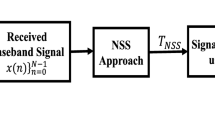Abstract
In cognitive radio applications, a robust detector is essentially required for the determination of spectrum sensing. Gerschgorin radii and centers ratio (GRCR) detector is a robust detector for cooperative spectrum sensing techniques. Covariance matrix generates the test statistics for signal established from one or supplementary sources. Though the method is robust against noise uncertainty, it is not suitable for wideband sensing due to the complexity associated with the computation of covariance matrix. To tackle this challenge of extensive communication cost and high processing time complexity, an efficient GRCR detector using compressive sensing with non-reconstruction is proposed here. This method introduces relevance for multiple received signals by using same measurement matrix to all received signals. Computational complexity is analysed and the proposed method is compared with the existing method through ROC simulations, and it shown that the proposed method performs better even in the low SNR range of -20 dB. Throughput analysis is validated through simulations.


















Similar content being viewed by others
References
Guimaraes, D. A. (2018). Robust test statistic for cooperative spectrum sensing based on the gerschgorin circle theorem. IEEE Access Feb, 2018.
Salahdine, F., Kaabouch, N., & El Ghazi, H. (2016). A survey on compressive sensing techniques for cognitive radio networks. Journal of Physics Communications, 20, 61–73.
Haupt, J., & Nowak, R. (2007). Compressive sampling for signal detection. In Proceedings of IEEE international conference on acoustics, speech signal processing, Honolulu, HI, USA, Apr. 2007, pp. III-1509–III-1512.
Mitola, J. III. (2000). Cognitive radio: An integrated agent architecture for software defined radio. Ph.D. dissertation, KTH Roy. Inst. Technol., Stockholm, Sweden, May.
Davenport, M. A., Boufounos, P. T., Wakin, M. B., & Baraniuk, R. G. (2010). Signal processing with compressive measurements. IEEE Journal of Selected Topics in Signal Processing, 4(2), 445–460.
Hong, S. (2010). Direct spectrum sensing from compressed measurements. In Proceedings of Military Communications Conference, San Jose, CA, USA, pp. 1187–1192.
Sharma, S. K., Lagunas, E., Chatzinotas, S., & Ottersten, B. (2016). Application of compressive sensing in cognitive radio communications: A survey. IEEE Communications Surveys & Tutorials, 18(3), 1838–1860.
Yucek, T., & Arslam, H. (2009). A survey of spectrum sensing algorithms for cognitive radio applications. Proceedings of the IEEE, 97(5), 805–823.
Darney, P. E., & Jacob, I. J. (2019). Performance enhancements of cognitive radio networks using the improved fuzzy logic. Journal of Soft Computing Paradigm (JSCP), 1(02), 57–68.
Liang, Y.-C., Zeng, Y., Peh, E. C. Y., & Hoang, A. T. (2008). Sensing-throughput tradeoff for cognitive radio networks. IEEE Transactions on Wireless Communications, 7(4), 1326–1337.
Zeng, Y., & Liang, Y.-C. (2009). Eigenvalue-based spectrum sensing algorithms for cognitive radio. IEEE Transactions on Communications, 57(6), 1784–1793.
Gao, Y., Chen, Y., Ma, Y., He, C., & Su, L. (2016). Eigenvalue-based spectrum sensing for multiple received signals under the non-reconstruction framework of compressed sensing. IEEE Access.
Valanarasu, R., & Christy, A. (2019). Comprehensive survey of wireless cognitive and 5G networks. Journal of Ubiquitous Computing and Communication Technologies (UCCT), 1, 23–32.
Haoxiang, W. (2019). Multi-objective optimization algorithm for power management in cognitive radio networks. Journal of Ubiquitous Computing and Communication Technologies (UCCT), 1(02), 97–109.
Bindhu, V. (2020). Constraints mitigation in cognitive radio networks using cloud computing. Journal of Trends in Computer Science and Smart technology (TCSST), 2(01), 1–14.
Funding
No funding.
Author information
Authors and Affiliations
Corresponding author
Ethics declarations
Conflict of interest
No conflict of interest.
Additional information
Publisher's Note
Springer Nature remains neutral with regard to jurisdictional claims in published maps and institutional affiliations.
Rights and permissions
About this article
Cite this article
Vivekanand, C.V., Bhoopathy Bagan, K. Performance Analysis of Robust GRCR Based Spectrum Detector Using Compressed Sensing with Non-reconstruction Model. Wireless Pers Commun 119, 2165–2184 (2021). https://doi.org/10.1007/s11277-021-08324-3
Accepted:
Published:
Issue Date:
DOI: https://doi.org/10.1007/s11277-021-08324-3




